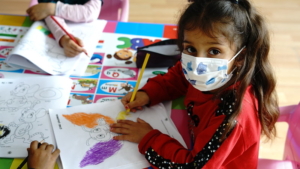
Sustainable Development Goals (SDGs) and the Fight Against Extreme Poverty
 According to a report by the World Bank, extreme poverty fell to pre-COVID levels in late 2023. This is a much quicker turnaround than many economists had originally thought, with some expecting this would take 10 years. While we can rejoice that this was not the case, the recommendations of those same economists - that donor countries must increase their aid budgets to recommended standards – still ring true.
According to a report by the World Bank, extreme poverty fell to pre-COVID levels in late 2023. This is a much quicker turnaround than many economists had originally thought, with some expecting this would take 10 years. While we can rejoice that this was not the case, the recommendations of those same economists - that donor countries must increase their aid budgets to recommended standards – still ring true.
COVID-19 in the Developing World
For many in the developed world, the detrimental impact of COVID was limited to restrictions on social gatherings, school and office closures and the cancellation of music and sports events. Of course, there were many tragic cases of lives lost too early, leaving a lasting impact on many. But thankfully for the majority of those in the West, society had the structural and digital frameworks to overcome the enormous shock that was the pandemic.
In contrast, COVID-19 in the developing world brought about different levels of devastation. It may have taken longer for the virus to seep into these countries, but when it did eventually hit, populations were more financially vulnerable and health systems were not ready.
It was apparent even amid the pandemic, that the least-developed countries were more vulnerable socioeconomically than the rest of the world. Where governments, businesses and individuals in developed countries may have had savings to fall back on allowing them to self-sustain and support one another, this was less often the case among the poorest countries in the world.
Moreover, certain disadvantaged groups such as women and less-educated workers were disproportionately affected by COVID-19, in middle and low-income countries in particular. As an aftereffect, millions more were plunged into extreme poverty during the year 2020.
COVID-19 and Extreme Poverty
The World Bank states that extreme poverty will mean people ‘are more likely to be malnourished, they have less access to services like education, electricity, sanitation and healthcare, and they are more vulnerable to conflict and climate change.’
Last year, the World Bank found that those in extreme poverty worldwide increased from around 700 million to more than 760 million in the year 2020. While this may not seem a seismic change, consider that this set us back to extreme poverty levels not seen since 2016. Only last year was it found that extreme poverty fell to pre-COVID levels. Although positive, the World Bank points out that considering these measures, we have lost three years in the fight against poverty worldwide.
Low-Income Countries Behind on the Road To Recovery
In many ways, to say that efforts to eradicate extreme poverty are back on track would be false. This is because all of the recovery has taken place in high- and middle-income countries. Many low-income countries are still experiencing increases in extreme poverty due to their incapability to roll out social welfare programs to counter the effects of COVID-19. This poses a huge problem for the aid sector as donor countries look to cut fiscal spending following the pandemic, but much of the developing world is now in need of aid more than ever. With the worst impacts of the climate crisis still to come, some have gone as far as suggesting that the aid system is running empty.
Aid Can Go a Long Way – How Extreme Poverty Fell
Back in 2020, researchers recommended that one way to reduce extreme poverty is to allocate more aid to low-income countries (LICs). This is because lower unit costs in those countries mean that development aid can go further and benefit more people. The Borgen Project has identified
SDGs, Targets, and Indicators
-
SDG 1: No Poverty
- Target 1.1: By 2030, eradicate extreme poverty for all people everywhere.
- Indicator: Extreme poverty fell to pre-COVID levels in late 2023.
-
SDG 3: Good Health and Well-being
- Target 3.8: Achieve universal health coverage, including financial risk protection, access to quality essential healthcare services, and access to safe, effective, quality, and affordable essential medicines and vaccines for all.
- Indicator: Health systems in developing countries were not ready to handle the impact of COVID-19.
-
SDG 5: Gender Equality
- Target 5.1: End all forms of discrimination against all women and girls everywhere.
- Indicator: Disadvantaged groups such as women were disproportionately affected by COVID-19 in middle and low-income countries.
-
SDG 10: Reduced Inequalities
- Target 10.1: By 2030, progressively achieve and sustain income growth of the bottom 40% of the population at a rate higher than the national average.
- Indicator: Extreme poverty increased from around 700 million to more than 760 million in 2020, setting back the fight against poverty worldwide.
-
SDG 13: Climate Action
- Target 13.1: Strengthen resilience and adaptive capacity to climate-related hazards and natural disasters in all countries.
- Indicator: The worst impacts of the climate crisis are still to come, posing a problem for the aid system.
-
SDG 17: Partnerships for the Goals
- Target 17.2: Enhance global macroeconomic stability, including through policy coordination and policy coherence.
- Indicator: Donor countries must increase their aid budgets to recommended standards.
Table: SDGs, Targets, and Indicators
| SDGs | Targets | Indicators |
|---|---|---|
| SDG 1: No Poverty | Target 1.1: By 2030, eradicate extreme poverty for all people everywhere. | Extreme poverty fell to pre-COVID levels in late 2023. |
| SDG 3: Good Health and Well-being | Target 3.8: Achieve universal health coverage, including financial risk protection, access to quality essential healthcare services, and access to safe, effective, quality, and affordable essential medicines and vaccines for all. | Health systems in developing countries were not ready to handle the impact of COVID-19. |
| SDG 5: Gender Equality | Target 5.1: End all forms of discrimination against all women and girls everywhere. | Disadvantaged groups such as women were disproportionately affected by COVID-19 in middle and low-income countries. |
| SDG 10: Reduced Inequalities | Target 10.1: By 2030, progressively achieve and sustain income growth of the bottom 40% of the population at a rate higher than the national average. | Extreme poverty increased from around 700 million to more than 760 million in 2020, setting back the fight against poverty worldwide. |
| SDG 13: Climate Action | Target 13.1: Strengthen resilience and adaptive capacity to climate-related hazards and natural disasters in all countries. | The worst impacts of the climate crisis are still to come, posing a problem for the aid system. |
| SDG 17: Partnerships for the Goals | Target 17.2: Enhance global macroeconomic stability, including through policy coordination and policy coherence. | Donor countries must increase their aid budgets to recommended standards. |
Copyright: Dive into this article, curated with care by SDG Investors Inc. Our advanced AI technology searches through vast amounts of data to spotlight how we are all moving forward with the Sustainable Development Goals. While we own the rights to this content, we invite you to share it to help spread knowledge and spark action on the SDGs.
Fuente: borgenproject.org

Join us, as fellow seekers of change, on a transformative journey at https://sdgtalks.ai/welcome, where you can become a member and actively contribute to shaping a brighter future.

